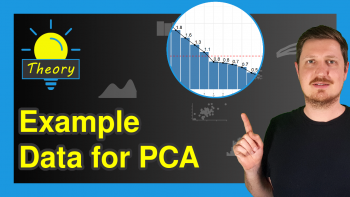Exploratory vs Confirmatory Factor Analysis
In this tutorial, I’ll explain the differences between Exploratory Factor Analysis (EFA) and Confirmatory Factor Analysis (CFA). First, I will start with introducing the concept of factor analysis, followed by concise descriptions of both EFA and CFA. To conclude, I’ll highlight the key differences between these two methodologies.
More specifically, the content of the tutorial is structured as follows:
Let’s get straight to the concepts!
Factor Analysis Overview
Factor analysis is a statistical method that seeks to uncover hidden factors or constructs within a dataset by examining the correlations among observed variables.
Instead of focusing on individual variables, factor analysis identifies groups of variables that move or behave together, suggesting they are influenced by common underlying factors. This method provides a clearer, organized view of complex datasets by highlighting these fundamental relationships and patterns.
For further information, see my Intoduction to Factor Analysis tutorial.
Exploratory Factor Analysis (EFA)
EFA is primarily deployed when researchers are in the early stages of understanding their data, especially when there’s ambiguity or uncertainty regarding its underlying structure. Without leaning on predefined models or assumptions, EFA dives into the dataset to uncover hidden patterns and relationships among the observed variables.
Its strength lies in its open-ended nature, allowing data to speak for itself and reveal its inherent structure. EFA is particularly useful when researchers aim to generate hypotheses, explore new domains, or lay the groundwork for further, more structured analyses.
In essence, EFA is about discovery, for further details on EFA, please visit my tutorial, Exploratory Factor Analysis.
Confirmatory Factor Analysis (CFA)
CFA is primarily utilized when researchers have a well-formed hypothesis or theory about the relationships within their data, particularly regarding its underlying structure. With a predefined model or set of assumptions in hand, CFA rigorously tests this model against the observed data to determine its fit and validity.
Its strength lies in its hypothesis-driven approach, validating the theoretical structures and ensuring that they align with empirical evidence. CFA is particularly valuable when researchers aim to confirm hypotheses, validate measurement instruments, or ensure that existing theoretical constructs are accurately represented in their data.
In essence, CFA is about validation, for a more detailed explanation see the tutorial, Confirmatory Factor Analysis (CFA).
Differences between EFA and CFA
The choice between them should be influenced by the research objective, theoretical background, and the depth of existing knowledge about the subject area. Let’s clarify the difference with help of a table comparing the features of the two methodologies.

As seen, despite both EFA and CFA are factor analyses, there is a fundamental distinction between them in terms of purpose, approach, and application. It’s essential for researchers to discern between these methods and choose appropriately based on the objectives of their study.
Video, Further Resources & Summary
Have a look at the following video on my YouTube channel. I show the examples of this article in the video:
The YouTube video will be added soon.
In addition to the video, you may want to have a look at the other posts on www.statisticsglobe.com. Some tutorials can be found below.
- Intoduction to Factor Analysis
- Exploratory Factor Analysis
- Confirmatory Factor Analysis (CFA)
- What is a Principal Component Analysis (PCA)?
In summary: On this page, I have explained when to select which factor analysis technique in the R programming language. Let me know in the comments, in case you have further questions.
This page was created in collaboration with Cansu Kebabci. Have a look at Cansu’s author page to get more information about her professional background, a list of all his tutorials, as well as an overview on her other tasks on Statistics Globe.







